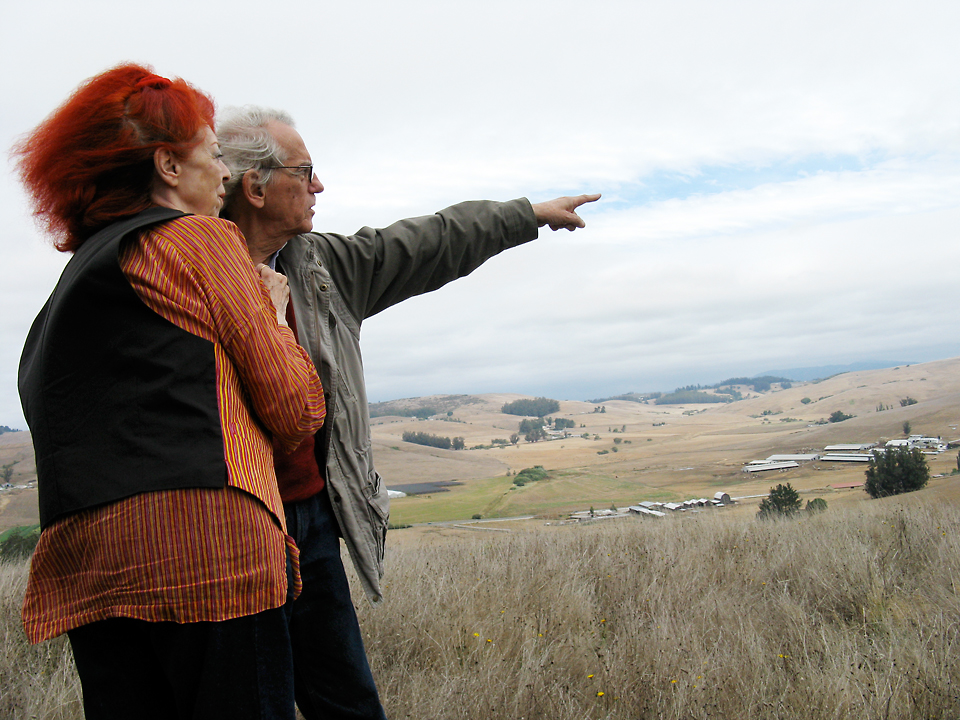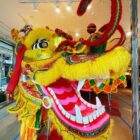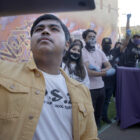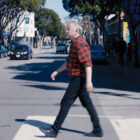In September 2009, artists Christo and Jeanne-Claude returned to Northern California for the 33-year anniversary of their “Running Fence” (1976) installation and to film “The Running Fence Revisited” (2010), directed by Wolfram Hissen and sponsored by the Smithsonian Museum of American Art.
During the filming, I did double duty as both writer and girl Friday for the crew. Between takes I interviewed Jeanne-Claude and Christo — at the Petaluma Denny’s, at a reunion picnic and in the car as they traced the route of where the fence had run. I may have been the last to interview Jeanne-Claude, who died suddenly on Nov. 18, 2009, at the age of 74.
The scenes described below first appeared in a slightly different form as the program for the documentary’s West Coast premiere back in June. “The Running Fence Revisited” was shown to a local audience that included the very ranchers and dairy farmers and laborers who helped make the "Running Fence" happen back in the 1970s. The film first was shown at the Union Hotel in Occidental and then at the Charles M. Schulz Museum in Santa Rosa. The film is also part of “Remembering the Running Fence,” an exhibit from the Smithsonian Museum of American Art, which will soon go on national tour.
On a cloudy day in Sonoma County, near hills over which the “Running Fence” once ran, Jeanne-Claude holds up her hands. She has piercing blue eyes, flame-colored hair, and gold bands on every finger, as if she’s married 10 different men rather than spent half a century at Christo’s side.
Each of her fingertips holds a piece of tape. We’re taping up posters of the artists’ epic outdoor projects: “The Gates” in New York’s Central Park, the wrapped Pont Neuf in Paris, the “Valley Curtain” in Colorado, the yellow and blue “Umbrellas” in California and Japan, the hot-pink “Surrounded Islands” in Miami’s Biscayne Bay.
It’s September 2009, and we’re setting up for a reunion that will be filmed for a documentary looking back on the work of art that burst into being in Sonoma and Marin counties 33 years ago. Before the guests arrive for a picnic at tiny Bloomfield Park, the artists and our three-person film crew are improvising a makeshift gallery on the outer wall of the park’s restroom.
Christo, stylishly rumpled and still boyish at 74, peers through horn-rimmed glasses to see if the “Running Fence” poster looks good next to the “Umbrellas.”
In the poster of the "Fence" you see how the 24.5-mile-long fence followed the sensuous curves of the land, becoming a steel-and-fabric echo of its contours.
Years later, the fence still echoes. The Smithsonian sings its praises and the locals chime in. "It changed the way people here think of art," says Gaye LeBaron, who covered the contentious permitting process for the Santa Rosa Press Democrat. "They’re not so quick to say, ‘That’s ridiculous.’ They’re more likely to give it some space."
A bit of history
In the early 1970s the people of Sonoma and Marin Counties were presented with what I’ll wager was one of the craziest ideas they’d ever heard. A fence? Made of cloth and going on for miles? For no reason other than the artists have one gigantic bee in their collective bonnet?
Though the artists had recently strung the crimson “Valley Curtain” in Colorado, their names weren’t widely known outside of the art world. They had a lot of convincing to do.
An early milestone in the process of radical persuasion came with a public screening of “Christo’s Valley Curtain” (1974), a film by David and Albert Maysles documenting the 1972 project in which the artists strung an orange curtain between two Colorado mountaintops. In one scene, a hard-hatted ironworker who helped run the cable watches as the fabric spills out of its protective cocoons. At first he waxes eloquent about the feats of engineering required for the project, but soon, his eyes on the unfurling of what looks like deep orange silk between two arid peaks, words fail him. Visibly moved, he seems to be grasping for words to describe his emotion. "It’s a … vision," says this rough-and-tumble Coloradoan.
It was probably this workingman’s response — more than that of the critics or supposed experts — that moved the people of Marin and Sonoma in the direction of saying Yes to the Running Fence.
Back at the park
At Bloomfield Park, old-timers are starting to arrive. Here’s the third wife of Spirito Ballatore (one the ranchers who supported the "Fence"); she’s celebrating her 93rd birthday today, and Christo and Jeanne-Claude kiss her cheek and present her with a large bottle of perfume. And there’s Leo and Rosie Ielmoroni, who we’ll visit with the cameras later in the day; in their farmhouse there’s a framed photo of the "Running Fence" not far from their gun case.
Leo, rancher and former rodeo operator, will make the crew laugh when he remembers that when he met the artists in the 1970s he was impressed that they were “a little bit smarter than the average bear. They could talk three languages, and they’d been around the horn one or two times.”
Men and women who worked on the "Running Fence" crew point themselves out in photos that George Gurney, deputy chief curator at the Smithsonian American Art Museum, is showing people in an attempt to identify all the actors in the 1976 drama.
"There I am," says former "Running Fence" crewmember Mike Manix, dressed in a black leather motorcycle jacket and looking like he could still hang a fence or two.
Sharon Menga, compact and with a pixie haircut, shows her own snapshots of when she worked on the fence, hooking the fabric to the cable. "She was one of our ‘hookers,’" laughs Jeanne-Claude. The 300 hookers were about half women and half men. But of the 60 people on the construction crew, only one was a woman.
Manix recalls that Ted Dougherty, one of the contractors for the project, said he wouldn’t hire Mike’s girlfriend for the construction crew and in fact wouldn’t be hiring any more women at all, because they had enough trouble already. At which point, Jeanne-Claude jumped in and said, "You hire her." And he did.
Across the lawn, filmmaker Wolfram Hissen interviews local Congresswoman Lynn Woolsey. German-born Hissen, with baby face and blond ponytail belying his 47 years, first started filming Christo and Jeanne-Claude’s work in 1985, when they wrapped Paris’ Pont Neuf. More recently he filmed, "On the Way to Over the River” (2007), a documentary chronicling the artists’ struggle to get the permits to suspend fabric panels over Colorado’s Arkansas River.
"As the idea of the ‘Running Fence’ became a bigger and bigger deal in our area," Woolsey reminisces, "it just seemed so outrageous to a young family, struggling like we were. But we followed it, and all of a sudden it was up. And I’m telling you, we were awestruck.”
The sun comes out, shooting its rays across Bloomfield Park. A man approaches Christo and Jeanne-Claude, grasping their hands. "I wasn’t here when the ‘Running Fence’ went up," he says. "But it’s an honor and a pleasure to meet you now."
Exactitude and pleasure
Over the next few days, I will hear many people say some version of this to Christo and Jeanne-Claude: It’s a pleasure and an honor to meet you. The people are sincere — it shows in their faces and you can hear it in their voices.
This time, Jeanne-Claude — dressed comfortably in jeans and low-heeled leather boots and wafting a trace of Thierry Mugler’s Angel perfume — smiles graciously at the man, but gently corrects him. "Not an honor," she says. "A pleasure, yes. We hope."
Her response became, for me, emblematic of the artists, in that it showed both their exacting nature and their insistence on pleasure.
Both (but especially Jeanne-Claude) are exact in their speech and expect others to take the same care. Though English was not her first language (she was born in Morocco to French parents), she spoke her adopted tongue both fluently and carefully. She was careful not because she feared making a mistake; she was careful because she didn’t want you, the listener, to make a mistake — to misunderstand her and her husband’s work.
In the film, we see Jeanne-Claude and Christo in their New York City loft. Christo is reminiscing about the contentious hearings in Sonoma and Marin counties. Many people testified for and against the "Fence," but when Christo had his turn at the microphone, he waved his arms to encompass both sides. "I said," Christo remembers, “ ‘Like it or don’t like it …’ "
"No," Jeanne-Claude interjects. "It was, ‘Whether you like it or not, you are all part of my art.’"
She smiles with satisfaction, as if it had been she who delivered that oft-quoted line.
Back at Bloomfield Park, Mary Ann Bruhn, who grew up on a farm and so always has everything on hand, has scared up some more pushpins to tack up more posters. "Good!" says Christo. "More pushpens." Jeanne-Claude corrects him. "Darling, it’s pushpins. Pushpins." She purses her bright lips. "It would make no sense, pushpens."
But beyond this exactitude, the artists are all about pleasure. It’s not the effort or struggle that stays with you after an encounter with the artists and their enchantingly unlikely projects. It’s delight, pure and simple.
In trying to describe Christo and Jeanne-Claude to friends, I keep circling back to metaphors that involve their material of choice — fabric. But not just any fabric —miles of fabric as strong as steel and as changeable as wind and water. It’s interesting that Christo’s family, as he was growing up in Bulgaria, owned a textile factory, and that fabric would become his material of choice. And the artists themselves are like their material; they are their material. Strong and supple, constant and changeable.
The nylon material for the "Fence," in fact, came from a manufacturer who was testing material for car air bags but made some of the samples too wide. The artists got it cheap, if 2 million square feet of anything can ever be cheap. When the "Fence" came down, most of the material went to the ranchers through whose land the fence ran. The fabric was stretched over many a manure pile, though four panels, painted burgundy so the local Rep theater company could use them as backdrops, are said to still hang in the Rio Theater in nearby Monte Rio. A group of women, including journalist LeBaron, made floor-length caftans from the fabric that they sported on Halloween, saying that collectively they were the "Running Fence." Photos of them dancing in their Fence frocks were published in Look magazine.
Lights on
Christo’s nephew Vladimir is driving us through a eucalyptus grove. It begins to rain. "Wipers on, lights on," says the Bulgarian native who lives in New York. I’m riding in the front with him, but out of the corner of my eye I see Jeanne-Claude and Christo in the back seat, two peas in a pod, born on the same day and inseparable in art and life since they met half a century ago. I’m thinking that in spite of the impact they’ve had on modern art, their story, for me, is first and foremost a love story. It’s about love of the world as it is, and love of how they might change it — how they might alter a landscape to make it even more itself. But above all, it’s a story of their love for each other.
"If I were writing for a woman’s magazine," I joke, "I’d ask, ‘How do you keep love alive?’"
Christo laughs, while Jeanne-Claude pronounces, "You don’t. Either it is or it isn’t."
Perhaps, but I observe how tender they are with each other, and how they still, after all these years, hold hands whenever they can.
In the film, we see Jeanne-Claude at a podium in New York City in 2005. She’s talking about the temporary nature of their projects. "We wish to give to our works," she says, "a quality of love and tenderness which is usually reserved for that which will not last."
And now, with the filming over and the scenes recorded for posterity, there is a haunting quality when we remember and evoke what is no longer with us — Jeanne-Claude herself, of course, and the artists’ installations, made all the more memorable for their temporary nature.
At the close of the Bloomfield Park picnic, Jeanne-Claude and Christo are saying their goodbyes. "Come back and see us again," someone says.
Jeanne-Claude laughs, "We will," she says. "And we promise, it won’t be another 33 years."
On Lonely Tree Hill
On a windy hillside not far from Bloomfield Park, the artists are trying to recall where the "Running Fence" cut across the landscape. We’ve driven in SUVs over a roadless rise.
The wind is wreaking havoc with Jeanne-Claude’s cotton-candy hair and Christo’s tufts of gray. As they pick their way through clumps of yellowed grass towards a tree on the horizon, they look fragile, and hold onto each other for balance. After a while they stop and face the camera. Christo speaks first.
"The ‘Fence,’ it was in front –"
"No, in back –"
"Yes, in back of the tree, so it must have been –"
"Yes, yes! It ran in back of the tree. You could —
"You could see the tree."
They interrupt each other, correct, repeat, and collaborate on the final answer to such an extent that it’s hard to tell who’s saying what. But the end result is that the artists agree: their "Fence" ran in back of this lone tree up on a bare Sonoma hill.
For a few moments no one speaks. The wind keens, and it’s getting cold. Christo and Jeanne-Claude turn back towards the cars, holding hands as they make their way.










